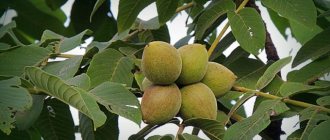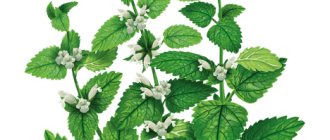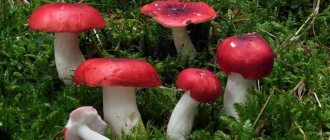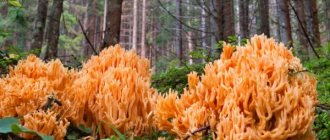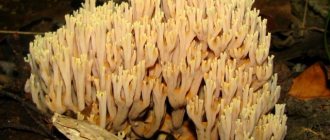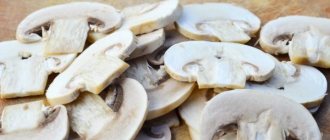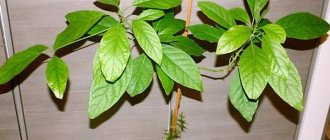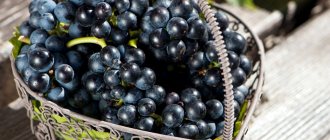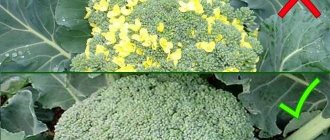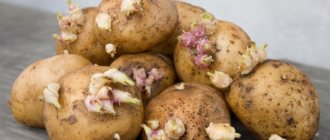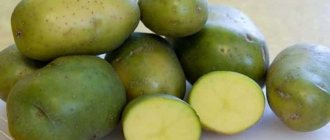The Manchurian tree, similar to a walnut, is not only an exquisite decoration of a natural or decorative landscape, but also a source of highly nutritious fruits and medicinal raw materials. Gardeners whose plots are decorated with Manchurian walnut have unlimited access to its medicinal fruits, bark, and shoots.
All parts of the tree are used in folk medicine, so growing walnuts has not only aesthetic, but also practical significance. From our article you will learn about the distinctive characteristics of the Dumbay nut, the secrets of growing it in the garden, as well as proper protection against pests, parasites, and infections.
Description of Manchurian walnut
Dumbey, Amur nut is a deciduous tree or bush, similar to a walnut. Does not form hazel.
The leaf blade is large, up to 1 m long, and consists of serrated leaves. There are 15 - 19 of them. They appear in mid-May, are bright and green until September, then turn yellow. The foliage releases phytoncides, biologically active esters. They suppress the development of bacteria and repel insects. The leaves fall early, all at once.
Simultaneously with the appearance of leaves, the Manchurian nut begins to bloom: how does the Manchurian nut bloom? Male flowers are long greenish catkins, and female flowers are clusters with small light flowers. Flowering lasts a week. The wind pollinates them.
The ovary forms the fruit. Nuts grow in clusters and are covered with pericarp. When ripe, the peel darkens, dries, and opens. 2nd half of September - harvest. Collected from the ground. One tree produces up to 70 kg of fruit.
The length of the nut is 6 cm. The shell is strong and thick. You cannot peel or chew it with your hands. The kernels are tasty and nutritious.
The trunk is straight, 10 - 25 m high. In the northern, cold regions it grows as a bush. The bark is initially light and smooth, but as the crop matures it begins to darken and becomes covered with cracks. Young shoots with a slight edge appear lighter than the main branches.
The crown is wide, spreading, forms a tent. Easy to model. The Manchurian walnut seedling can be trimmed as the owner likes. The crown is given the shape of a ball or palm tree. Limit the height of the trunk or create a large shrub.
The root system is powerful and deep. When planting, the central root is pruned to ensure overall development of the plant. The lateral branches lie shallow. On the slopes of ravines and gullies, planting Manchurian walnut trees will strengthen the soil against landslides.
The culture is light-loving and wind-resistant. Tolerates frosts and temperature changes; adults are not afraid of frosts or heat. Amur nuts are planted along roads and streets. He is not afraid of dust, smoke, gas pollution in cities.
How fast does Manchurian nut grow?
Ussuri hazel seedlings develop quickly, reaching 50 - 100 cm by autumn. Four-year-old seedlings - 2 m. Mature trees - up to 25 m. Active growth continues until 20 - 30 years, then the rate decreases.
Under natural conditions, hazel grows up to 90 years, its life expectancy is 200 years.
What year does the Manchurian nut bear fruit?
With proper planting and care, the Far Eastern crop will bloom in 3 years. The first fruits may ripen. The plant will produce a full harvest from 10 to 12 years of age. Nuts ripen annually, every 2 years - abundantly. Hazel bears fruit for 100 years.
Why does the Manchurian nut not bear fruit?
Are there no fruits or the collected nuts are empty? There may be several reasons:
- trees are protected from the wind by other plantings and buildings. Pollination does not occur. There will be no harvest;
- infertile soil;
- loneliness of the plant;
- In the spring, the catkins and female flowers froze. Growth will begin in the summer from dormant buds. The fruits will not have time to ripen;
- the ovary was damaged by insects.
Origin and exporting countries
The homeland of the Amur walnut is Northern China, Manchuria. Distributed in the Far East: Primorye, Amur region. Now it grows in Sakhalin, Altai, the south of the Krasnoyarsk Territory, and in North America.
Farmers across the country know how to grow “cultivated” Manchurian nuts. It successfully bears fruit in the Vologda, Leningrad, and Moscow regions.
Every year, dozens of seedlings are sold by nurseries:
- Garden centers of the Moscow region;
- Kemerovo region, Novokuznetsk district - “Siberian Garden”;
- Nizhny Novgorod, Bogorodsky district, Novinki village - “Alley”.
There is no export of Dumbey nuts at a high level. Throughout Russia, official transportation of fruits purchased via the Internet is carried out.
Manchurian walnut in landscape design
By planting Manchurian walnut in your country house or on your personal plot, you can not only get a useful plant that produces tasty fruits, but also make it part of your unique landscape design. In addition to its decorative properties, it is also useful because it repels mosquitoes. The main reasons why many people are happy to plant this plant for landscaping are:
- Unpretentiousness and ease of care, good adaptability to external natural conditions.
- The beneficial properties that the plant has add points when choosing a tree for the site.
- Decorative. Manchurian walnut looks equally impressive both in group plantings and in single plantings.
- To all the advantages you can add the possibility of forming a tree crown. One of the most favorite techniques of landscape designers is the crown of a walnut in the form of a palm tree. This, in addition to its beautiful appearance, makes it possible to plant other, shorter plants in close proximity to the tree.
- Excellent combination with other trees. Walnut looks very beautiful against the background of its coniferous counterparts.
Growing Manchurian walnut
Manchurian nut grows in the Far East, China, and Korea. It is also called Dumbey or Amur. The habitats of the Ussuri hazel are mixed forests. Neighbors: oaks, maples, spruces, larches. Breeders have bred 20 types of nuts for various regions of Russia.
How to grow Manchurian walnut at home
The wild Amur nut, 25 meters high, with a wide spreading crown, lives and bears fruit for 200 years. The fruits are similar to walnuts, just as tasty, nutritious and healthy. The plant is distinguished by its resistance to cold, winds, and unpretentiousness.
Farmers in the Urals, Siberia, and Moscow region value the Manchurian walnut for its external beauty, internal usefulness, and abundant fruiting. If desired, everyone can grow the Amur culture on a personal plot, street, or in the courtyard of a house.
Proper planting of seeds, seedlings, caring for young trees is all that a capricious plant needs.
Propagation by seedlings
The decision to plant the nut “Amur” must be thought out. Buying annual seedlings is half the battle. You need to study the rules for planting Manchurian walnuts:
- choose a place that is open, sunny, with fertile soil;
- planting time - mid-spring or early autumn;
- hazel leaves secrete phytoncides. They repel insects, but slow down the growth of neighboring plants;
- a wide, strong root system can destroy the foundation of a house if the tree is planted closer than 10 m;
- the distance between seedlings is ten meters;
- planting hole - 1 m², depth - according to the condition of the root (the central one is trimmed so that the main growth occurs on the tree itself);
- Place broken bricks, pebbles or crushed stone at the bottom of the hole, cover the drainage with a layer of earth, pour out a bucket of water;
- the next layer - old manure, humus, wood ash, 20 g of superphosphate - cover with fertile soil;
- Carefully place the seedling, tie it to a support, pour out the soil, compact it, water it again;
- lay leaves, bark, small branches or straw around the trunk;
- After 5 - 7 days, water again.
Propagation by seeds
The Manchurian tree can be propagated not only by seedlings, but also by seeds. Select nuts for future planting that are intact, without damage, darkening, or holes. Fresh or last year, not older. With age, seed germination decreases.
Autumn sowing
For every square meter of fertile soil, 200 - 300 g of wood ash is added. Dig up the soil and form beds. Place the seeds on their edges, 10 cm apart. Cover with soil, water, and put leaves or sawdust on top.
After a year, select strong seedlings and transplant them to a permanent place. Trim the central root. Developed wood will help withstand winter frosts.
In spring, prepared seeds germinate better. Fresh or annual Manchurian nut fruits are stored in a cool place.
There are 2 germination methods. The first is simpler: the seed material is poured with hot water for a day. Transfer to a box with damp sand and store at room temperature.
After a month they are planted in a permanent place. If you plan to grow Ussuri hazel on the street or along the road, then the seedlings are planted in large pots until they get stronger.
Second way:
- november. Cover the fruits with clean, damp sand and cover with polyethylene;
- control humidity, mold;
- March. Remove the seeds and rinse. Fill with warm water for 10 days;
- lay in the ground to a depth of 7 cm, at room temperature;
- April. Sprouts will appear or the shell will open slightly. You can plant it in the prepared place.
Experienced gardeners advise taking into account the climatic conditions of the region. April is different everywhere. It’s easier to immediately cover the bed with covering material or film (make holes).
Beneficial features
The fruits have unique antimicrobial properties. The nut also has many other beneficial qualities:
- A decoction of the leaves has a positive effect on hair (removes dandruff, accelerates growth, gives hair a beautiful and natural shine).
- From unripe nuts you can make not only tasty, but also very healthy jam.
- Manchurian nut fruits can be included in a balanced diet, as they contain more than 45% healthy fats.
- To get rid of fungus on the feet or nails, you need to brew the leaves of the nut and immerse your feet in the broth for 30 minutes.
- Fresh and clean leaves can be applied to wounds to prevent rotting.
- The plant contains a bactericidal substance that effectively cleanses the atmosphere of dust, gas and harmful fumes.
- A decoction of the leaves is used to cleanse the blood and treat tuberculosis.
Each part of the tree, from leaves to bark, contains many useful components, such as:
A unique crop is the Manchurian walnut.
Manchurian walnut care
Mature trees cope with frosts and are not afraid of rodents, heat, or wind. Pruning for Manchurian walnut is usually sanitary. Caring for Manchurian walnut seedlings is more complex:
- One-year-olds need to be watered 2 times a month. If there is a drought - more often. Two to three year old plants every three weeks;
- loosen the soil under the tree, remove weeds, cover with sawdust or bark. The earth is saturated with oxygen and moisture is retained;
- Apply fertilizers at the roots in June. A mixture of superphosphate and wood ash is used;
- the fragile trunk is protected from sunlight with a lime mortar and clay.
Four-year-old hazel will begin to bloom. With proper care, the first fruits will appear.
Manchurian nut: benefits and harm for the human body
Manchurian nut is a plant that is known throughout the world for its healing properties and beneficial properties for the human body. And this is not in vain, since the leaves, bark and fruits of the Manchurian nut contain many components that are necessary for the human body. Among these components, scientists identify the following:
- vitamins group A, B and C;
- tannins;
- potassium, magnesium, carotene;
- phytoncides, alkaloids;
- malic, gallic, citric acids;
- coumarins and vitamins of group P, which are contained in the fruits of the plant.
The oil, which is obtained from the kernels of the Manchurian nut, contains many beneficial acids that have a unique effect on the human body.
Among such acids, science has identified the following:
- linoleic;
- linolenic;
- oleic;
- palmitic;
- stearic
Manchurian nut oil is not inferior in composition to corn oil, which ranks first in the world in terms of linoleic acid content.
In addition, Manchurian nut oil is superior in its distinctive properties to other oils necessary for humanity.
Based on the composition of this culture, the following beneficial properties are identified:
- increasing the body's immunity;
- improving the functioning of the gastrointestinal tract;
- positive effect on the skin and hair of the body;
- assistance in healing wounds and preventing various diseases after injuries;
- analgesic effect;
- diuretic and vasodilating effects;
- anti-inflammatory effect;
- antifungal property.
However, despite all the positive properties, the nut has one drawback - it causes a strong allergic reaction to its consumption, so it is necessary to first check the body's reaction.
Crown formation
Amur hazel is one of the rare plants that can be given the desired appearance. Farmers have long known how to form the crown of the Manchurian walnut. It is organically “fitted” into small or huge areas, the height and width are controlled. A hazel tree can become a bush or a tree.
Bushes are formed along the site or ravine to strengthen the slope. 5 - 7 trunks are left, the side branches are cut off. New shoots will come from the root. The bush will gradually become denser.
A low, spreading nut will be obtained if the seedling has one strong shoot (this will be the trunk). Its branches will become skeletal for the future tree. Select those that are at the same angle relative to the trunk. Cut off the remaining shoots and branches.
Next year, limit the height of the trunk by pruning from above. The crown of the tree does not develop upward, spreads widely, and provides shade.
In limited spaces, gardeners “create” tall single-trunk trees with a compact arrangement of branches. On the central shoot, all buds are removed from below. Hazel grows, blooms, and bears fruit at the top, without shading the beds of other plantings.
Plants with a spherical crown type perform decorative functions. They decorate gardens, parks and public gardens with dignity. The “ball” is the result of trimming. The lower and upper branches are cut off more than the central ones.
You can experiment with the Amur form already in the second year, 5 - 6 years.
Where is the best place to plant Manchurian walnut?
To choose the ideal place to plant a plant, it is worth considering a number of important features of its growth.
- It is immediately recommended to choose a permanent place, because Manchurian walnut does not tolerate transplantation very well.
- It is not recommended to plant it near other hazel trees; it does not tolerate such proximity very well.
- The soil must be fertile and well drained. If the soil is poor, then you will definitely need to take care of applying fertilizers, both chemical and biological.
- Walnut does not tolerate shade well, so you should choose sunny places for planting.
- It is worth considering the size of the tree and other plants, as well as the building. So, the optimal distance to other objects is on average 6 m.
- Manchurian nut, planted next to grapes, can cause the death of the latter.
How to prepare Manchurian nuts for winter
The system of methods for growing Manchurian nuts is agricultural technology. Its task is to create conditions for growth and development of culture. One important way is to prepare young plants for wintering.
Adults tolerate frost, wind, and temperature changes. The youngsters can't handle it on their own. They need to be covered for two or three winters.
The stems and lower branches are covered with cotton fabric, burlap or covering material. Be sure to secure it.
Dig a metal mesh around the young plantings. It will protect against underground rodents and hares. Compact the snow so that pests do not get through it to the fragile bark.
Care
It is not difficult to grow a nut, since the plant does not require much care.
After planting, care consists of regular irrigation, fertilizing, mulching, protection from frost and parasites.
In addition, the plant should be protected from rodents. To do this, install a fine-mesh metal mesh about a meter high at a distance of 10–15 cm from the tree trunk. To prevent sunburn, whitewash the trunk or plant tall trees nearby: linden, birch, beech, spruce.
Watering
Walnut trees have a high need for moisture, the plant is irrigated regularly, avoiding stagnation of liquid. At normal levels of precipitation, adult plants are watered 5 times per season, young plants - twice as much. During drought, 15-20 liters are irrigated weekly. By autumn, watering is reduced, allowing the nut to prepare for winter.
Selection of fertilizer and feeding
Once during the growing season (preferably in June), the nut is fertilized with phosphorus-potassium compounds. You can feed it with nitrogenous fertilizers in the spring, and in the winter with wood ash, which contains a set of macro- and microelements necessary for the normal development of the crop and obtaining a large harvest.
Mulching
Mulching allows you to retain moisture in the soil, insulate the roots from frost, and protect from weeds and sunlight. It is advisable to mulch Manchurian walnut immediately after planting. Sawdust, peat, moss, and hay are used as mulch.
To enhance the effect of mulching, it is advisable to do it immediately after fertilizing. When using organic matter, the mulch layer depends on the material: moss - 10 cm; sawdust -7 cm; foliage or hay - 10-15 cm.
Preparing for winter
In the fall, you need to protect the trunk of the Manchurian walnut from the approaching frosts by wrapping it in felt, matting, burlap, or agrofibre. For insulation, you can build a frame, filling it with sawdust on top or wrapping it in non-woven material.
Acrylic or latex-based garden paint will help increase resistance to frost and protect against burns.
Pests and diseases
The Manchurian walnut variety has good immunity, but diseases can affect the condition of the leaves, bark, and branches. Each disease has causes and progresses with its own characteristics:
- Black spot is a fungal disease that occurs in high humidity. It manifests itself in the formation of small dark spots on the leaves of the plant. In the absence of treatment, part of the crown of the Manchurian walnut dies off and the tree weakens. Copper solutions are used for prevention and treatment.
- A tinder fungus that destroys wood, causing the nut to dry out. The mushrooms must be cut off and burned, and a solution of copper sulfate should be applied to the affected areas.
- The gallworm is a parasitic insect that attacks the bark, leaves and flowers of trees. You can get rid of the pest by cutting off the affected branches. If large areas are affected, spray with insecticides: decis, kinmiks, carfobs.
- Fire blight is an infectious disease caused by bacteria of the genus Erwinia. It manifests itself as darkening and wilting of inflorescences, then leaves, young branches and bark are affected. Treat with Bordeaux mixture and antibiotics.
- Gall-forming mite - affects leaf blades and deforms young shoots. To get rid of it, they spray it with organophosphorus compounds, neonicotinoids, and pyrethroids. Severely damaged branches are removed and burned.
When properly grown, the Manchurian nut develops quickly and produces its first harvest within a few years after planting. In addition to regular irrigation and prevention of bacterial and fungal diseases, you should weed and loosen the soil around the trunk.
Features of cultivation in different regions
The successful cultivation of Ussuri hazel in areas with different climates is explained by varietal characteristics. It tolerates low temperatures, heat, and gusts of wind.
The Manchurian walnut grows in the snows of Siberia, the Urals, Moscow and Leningrad regions. The rules for germinating seeds are the same, regardless of the region. The principles of care differ.
Growing Manchurian walnut in Siberia
Winter cold is tolerated well by perennials. The late Siberian spring allows plants not to suffer from the last frosts.
Seeds are planted in beds in May. Young seedlings are covered with cloth and snow in the fall.
A special feature of growing in harsh climates is the formation of a bush. In the second year, the stems are cut to the level of the stump. Multiple side shoots will create a future plant. It is necessary to prune and maintain shape annually.
Watering, digging, removing weeds, and fertilizing are carried out in the same way as in all other areas. The loose, fertile soil around the bush is covered with a layer of leaves, straw or sawdust.
Growing Manchurian walnut in the Urals
Specifics of cultivation in the Urals:
- the appearance of the hazel is a low bush;
- planting seeds and replanting annual plants is carried out in the spring;
- pruning - early July;
- in the fall the bush is bent down and covered completely with covering material;
- In winter, snow is thrown on top and compacted with a shovel.
Growing Manchurian walnut in the Moscow region
It is necessary to insulate young plantings in late autumn. Wrap up the trunks and lower branches. The fallen snow is trampled down tightly.
Spring frosts are dangerous for shoots, flowers, and ovaries. They freeze at sub-zero temperatures. In the evening, plantings can be covered with polyethylene. The greenhouse effect will protect seedlings and seedlings from freezing.
In summer - watering and fertilizing. Whitewashing the bottom of the walnut will protect it from sunlight. Burns are dangerous for thin bark.
Features of correct landing
Planting Manchurian walnut requires the following conditions:
- The planting site must be chosen large so that nothing grows tens of meters from the planted plant. It should be remembered that fruit plants that will grow with Manchurian nut will experience discomfort, so you should not plant them all together. The planting site must be well lit and have moist soil for the development of the plant's root system.
- It is advisable to plant Manchurian walnut in the fall, preferably in October or November, since it is at this time that the plant can receive all the necessary nutrients from the soil.
- It is necessary to dig a deep hole, since the plant itself is large, which means its root system will only grow every year.
- During planting, it is necessary to add various organic substances (peat, manure, humus, compost and others) or drainage, which will consist of stones, bricks and crushed stones, into the hole.
- After adding drainage or organic matter, the next layer should be sand.
- After all the steps taken, a support is placed on the seedling that will prevent it from dying, the soil is mulched, compacted and watered abundantly.
How to propagate Manchurian walnut
A lonely Dumbey nut pleases the eye and protects from the bright sun. Doesn't bear fruit. Why?
Its male and female flowers develop simultaneously. The branches did not receive a shake from the wind, the people did not receive fertilization. There will be no harvest either. Breeders advise planting a second plant.
You can buy a seedling, grow it yourself, propagate your plant with seeds, or improve its quality by grafting.
Manchurian nut grafting
An adult tree is not suitable for propagation by grafting. Choose young hazel, its bark is smooth and elastic. The best scion is walnut. Intensive watering is necessary before surgery.
Description of the procedure:
- 2 horizontal cuts are made at a height of 5 m from the root.
- Two vertical cuts to create an area of 3 cm².
- Part of the wood with a bud is cut from a walnut tree.
- Without touching the exposed tissue with your hands, apply the kidney and wrap it with plastic tape, film or cloth.
- Keep the soil moist, loosen the bandage after 2 weeks, make sure the wounds heal.
Proper care will allow you to grow a plant with qualitatively new properties.
Manchurian and walnut - differences
These plants belong to the same species and are very similar, both in appearance and in the taste of the fruit, but there are a number of differences that are worth paying attention to.
- The Manchurian nut is much more powerful and impressive than the walnut; it grows and bears fruit faster.
- Walnut is less frost-resistant, so Manchurian is an excellent alternative for areas with cold climates.
- The shell of the Manchurian nut is much denser and harder; it is not so easy to split it even with the help of, for example, a hammer.
- Another indicator of how a walnut differs from a Manchurian one is the size of the fruit, which is much smaller than its Chinese counterpart and has an oval shape.
- The fruits of the Manchurian relative do not have partitions when fully ripe.
- In open areas, the Chinese relative can take the form of a bush.
- Walnut is not so demanding on soil moisture.
Pests and diseases of Manchurian nut
The Far Eastern nut is protected from insects by phytoncides and plant antibiotics. They are not afraid of gall mites and gall mites. Most often, insects do not cause much harm to the tree. The crop may suffer.
The gallworm larvae feed on the sap of leaves, flowers, and ovaries. Plantings are treated with a solution of karbofos (45 g per 5 liters of water) in early spring. Severely affected branches should be cut off and burned.
The gall mite lays eggs inside the buds and disrupts the leaf structure. It will take 2 insecticide treatments. The first is before flowering. The second is in the summer.
In the cold, damp summer, the leaves of the Manchurian nut begin to turn black. Black spot fungus is destroyed with copper sulfate or other copper-containing preparations.
It is possible to grow Amur nuts in any area if you follow simple rules. Easy care and annual harvests of tasty, healthy fruits attract the attention of breeders and gardeners from various regions of Russia.
Disease and pest control
Despite good immunity, Juglans mandshurica needs additional protection from parasites and pests.
Their attack provokes the development of diseases of leaves, bark and shoots, which can lead to serious developmental disorders and even death of the plant. If it does not bear fruit, the Manchurian nut needs immediate treatment or parasite control.
The most common diseases to which plants grown in the country are susceptible:
- Black spotting is caused by a fungus that appears in conditions of excess moisture. Leads to the development of small dark spots on the leaves. If the plant is not treated, it will weaken, and some of the branches may die. Black spotting can be prevented and cured using honey solutions.
- Polypore fungi are parasites that destroy the bark, which leads to drying out of the trunk. If growths are detected, they are cut off immediately. The mushrooms themselves should be burned, and the places where they grow should be treated with a solution of copper sulfate.
- The parasitic nutcracker is a common parasitic insect in the Far East that affects all parts of the tree (bark, foliage, branches, inflorescences). To get rid of the insect, you need to cut off all the branches damaged by it and burn them. After this, the shoots are treated with insecticides, for example, Kinmiks.
- Bacterial burn is an infectious disease caused by a pathogen from the genus Erwinia. Manifestation - in the form of focal darkening on the bark and wilting of flowers. If the plant is not treated, the bacterium will spread to the foliage and bark, and the Dumbai cedar will stop bearing fruit. For healing, Bordeaux mixture is used, as well as antibiotics.
- Gall-forming mite - destroys leaves and also leads to deformation of young petioles. To combat the parasite, it is necessary to spray all plantings with organophosphorus compounds and pyrethroids. Damaged branches will not revive, so they should be pruned and burned.
Manchurian walnut is an excellent decoration for any area. Planting and caring for this tree does not require effort or time, while a beautiful plant will delight the eye for many years. The fruits and leaves of the Manchurian nut can be used to make tinctures and ointments - excellent prevention of chronic diseases.
